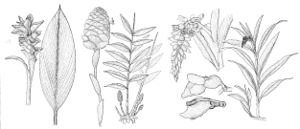Difference between revisions of "Curcuma zedoaria"
Transactions of the Linnean Society of London 8: 354. 1807.
Common names: Zedoary
IntroducedIllustrated
Basionym: Amomum zedoaria Christmann in G. F. Christmann and G. W. F. Panzer, Vollst. Pflanzensyst. 5: 12. 1779
Synonyms: Curcuma pallida Loureiro
Treatment appears in FNA Volume 22.
FNA>Volume Importer |
imported>Volume Importer |
||
| (5 intermediate revisions by 2 users not shown) | |||
| Line 8: | Line 8: | ||
}} | }} | ||
|common_names=Zedoary | |common_names=Zedoary | ||
| − | |basionyms={{Treatment/ID/ | + | |special_status={{Treatment/ID/Special_status |
| + | |code=I | ||
| + | |label=Introduced | ||
| + | }}{{Treatment/ID/Special_status | ||
| + | |code=F | ||
| + | |label=Illustrated | ||
| + | }} | ||
| + | |basionyms={{Treatment/ID/Basionym | ||
|name=Amomum zedoaria | |name=Amomum zedoaria | ||
|authority=Christmann | |authority=Christmann | ||
| + | |rank=species | ||
| + | |publication_title=in G. F. Christmann and G. W. F. Panzer, Vollst. Pflanzensyst. | ||
| + | |publication_place=5: 12. 1779 | ||
}} | }} | ||
|synonyms={{Treatment/ID/Synonym | |synonyms={{Treatment/ID/Synonym | ||
|name=Curcuma pallida | |name=Curcuma pallida | ||
|authority=Loureiro | |authority=Loureiro | ||
| + | |rank=species | ||
}} | }} | ||
|hierarchy=Zingiberaceae;Curcuma;Curcuma zedoaria | |hierarchy=Zingiberaceae;Curcuma;Curcuma zedoaria | ||
| Line 30: | Line 41: | ||
|elevation=50 m | |elevation=50 m | ||
|distribution=Fla.;native;Asia (ne India). | |distribution=Fla.;native;Asia (ne India). | ||
| + | |introduced=true | ||
|discussion=<p><i>Curcuma zedoaria</i> is grown commercially in Asia for its starchy rhizome, which is used as a condiment or tonic.</p> | |discussion=<p><i>Curcuma zedoaria</i> is grown commercially in Asia for its starchy rhizome, which is used as a condiment or tonic.</p> | ||
|tables= | |tables= | ||
| Line 39: | Line 51: | ||
-->{{#Taxon: | -->{{#Taxon: | ||
name=Curcuma zedoaria | name=Curcuma zedoaria | ||
| − | |||
|authority=(Christmann) Roscoe | |authority=(Christmann) Roscoe | ||
|rank=species | |rank=species | ||
| Line 54: | Line 65: | ||
|publication title=Transactions of the Linnean Society of London | |publication title=Transactions of the Linnean Society of London | ||
|publication year=1807 | |publication year=1807 | ||
| − | |special status= | + | |special status=Introduced;Illustrated |
| − | |source xml=https:// | + | |source xml=https://bitbucket.org/aafc-mbb/fna-data-curation/src/2e0870ddd59836b60bcf96646a41e87ea5a5943a/coarse_grained_fna_xml/V22/V22_584.xml |
|genus=Curcuma | |genus=Curcuma | ||
|species=Curcuma zedoaria | |species=Curcuma zedoaria | ||
Latest revision as of 20:32, 5 November 2020
Leaf blades narrowly ovate or elliptical, 45–67 × 15–22 cm. Inflorescences erect, 11–23 × 5–10 cm; bracts of main axis whitish proximally, green (proximal bracts) or pink (distal bracts) distally; proximal bracts ovate to rectangular, deeply saccate, 4–4.5 × 4 cm, apex obtuse or truncate-apiculate; distal bracts narrowly ovate, 8–9 × 4–4.5 cm, apex rounded. Flowers: perianth white or spotted with purple; staminodes pale yellow with yellow streak down center of lip.
Phenology: Flowering spring (May).
Habitat: Disturbed lakeshore
Elevation: 50 m
Distribution

Introduced; Fla., native, Asia (ne India).
Discussion
Curcuma zedoaria is grown commercially in Asia for its starchy rhizome, which is used as a condiment or tonic.
Selected References
None.
Lower Taxa
None.
